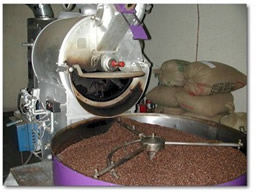 Coffee roasting is a chemical process by which aromatics, acids, and other flavor components are either created, balanced, or altered in a way that should augment the flavor, acidity, aftertaste and body of the coffee as desired by the roaster.
Coffee roasting is a chemical process by which aromatics, acids, and other flavor components are either created, balanced, or altered in a way that should augment the flavor, acidity, aftertaste and body of the coffee as desired by the roaster.
Roasting Coffee Beans
The first stage is endothermic. The green beans are slowly dried to become a yellow color and the beans begin to smell like toast or popcorn.
The second step, often called the first crack, occurs at approximately 205 °C (400 °F) in which the bean doubles in size, becomes a light brown color, and experiences a weight loss of approximately 5%. The corresponding Agtron number for this color is between 95-90 (Davids, 68-69).
In the next step the temperature rises from 205 °C to approximately 220 °C, the color changes from light brown to medium brown (Agtron # 60-50), and a weight loss of approximately 13% occurs (Davids, 68-69). The resulting chemical process is called pyrolysis and is characterized by a change in the chemical composition of the bean as well as a release of CO2.
The second step is followed by a short endothermic period which is followed by another exothermic step called the second crack. This second pyrolysis occurs between 225-230°C, and the roast color is defined as medium-dark brown (Agtron #50-45) (Davids, 68-69). The second pop is much quicker sounding and the beans take on an oily sheen.
 Espresso potential is maximized in roasting when you maximize the sweetness and aroma of the coffee while minimizing the bitterness and acidity. Most people focus on the latter and therefore roast extremely dark, yet without sweetness and aroma the espresso will never be palatable. This explains the unpopularity of straight espresso and the popularity of espresso based drinks where either milk or other flavors are used to replace the sweetness that was lost by roasting darkly.
Espresso potential is maximized in roasting when you maximize the sweetness and aroma of the coffee while minimizing the bitterness and acidity. Most people focus on the latter and therefore roast extremely dark, yet without sweetness and aroma the espresso will never be palatable. This explains the unpopularity of straight espresso and the popularity of espresso based drinks where either milk or other flavors are used to replace the sweetness that was lost by roasting darkly.
From 170-200°C the sugars in coffee begin to caramelize. From tasting pure sugar versus its caramelized component it is evident that uncaramelized sugar is much sweeter. The dark color of coffee is directly related to the caramelization of the sucrose in coffee. Therefore, to maximize sweetness you want to minimize the carmelization of sucrose, yet you do not want to roast too lightly or bitter tasting compounds will not thermally degrade. Stop the roast somewhere between the end of the first crack and less than half way through the second crack. Do not roast well into or past the second crack. We recommend a roasting chamber temperature somewhere between 205-215°C. Realizing the danger of the following suggestion we might recommend a color similar to the one below. Note: All monitors, computers, and internet browsers will display the color slightly different. This is only a recommendation to point out that this color is preferable to the almost black color you will frequently observe for espresso. To get a better idea of roasting colors order the Agtron roasting classification kit from the SCAA
